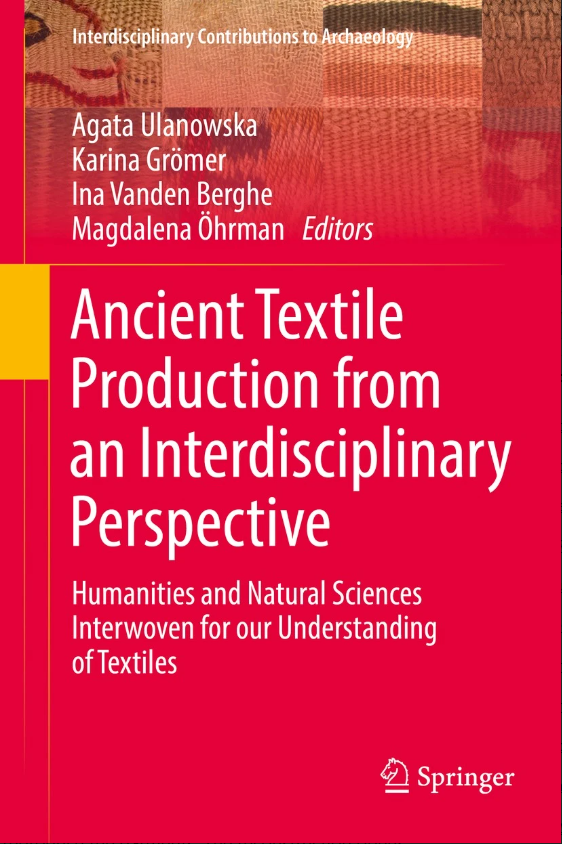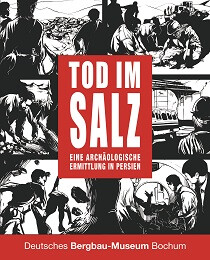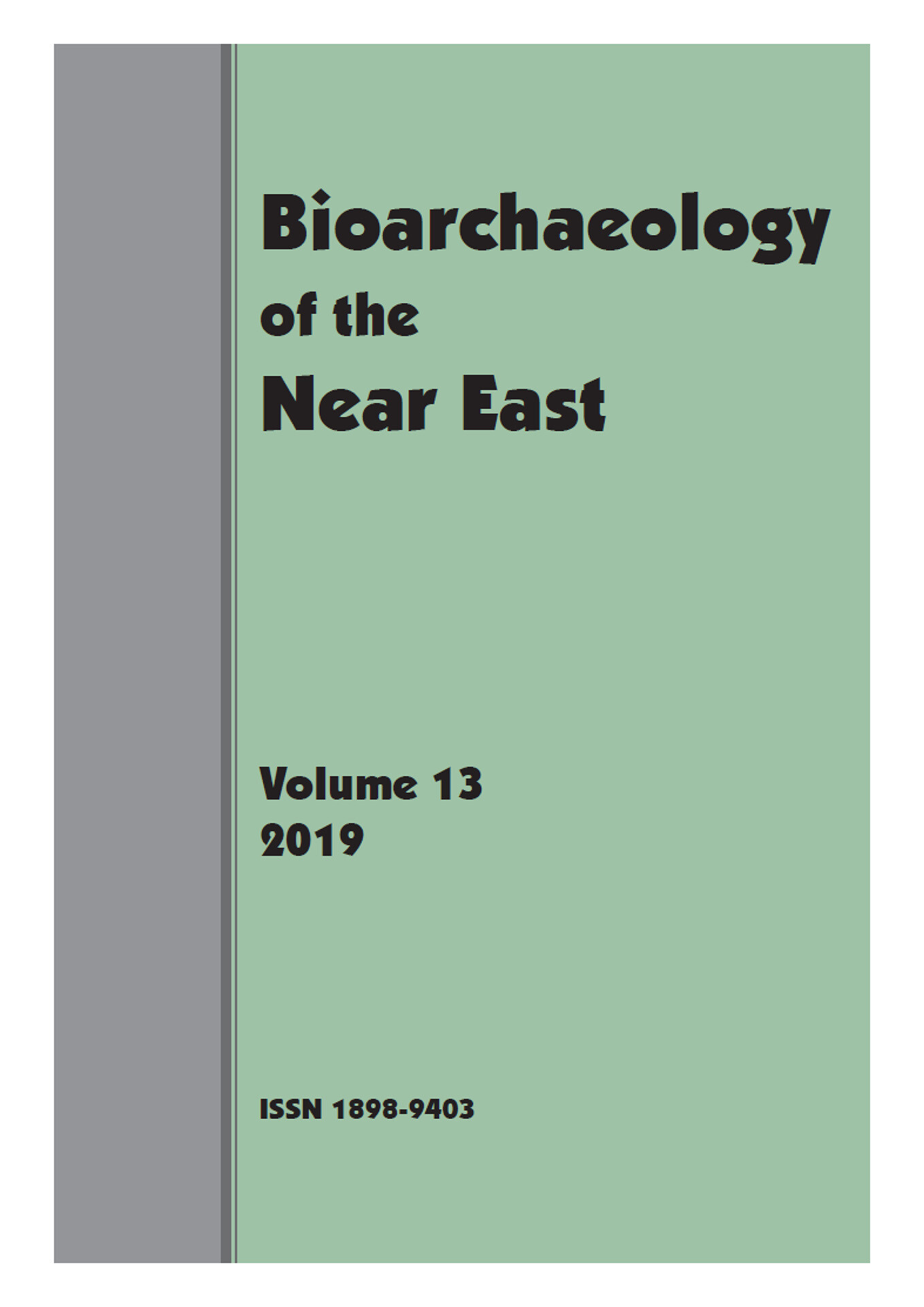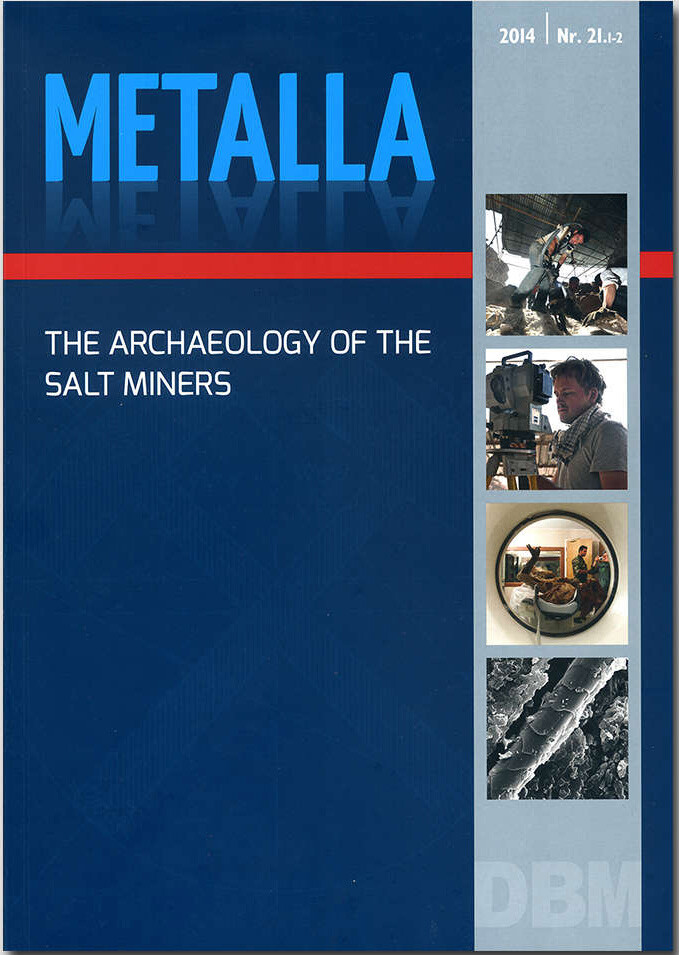Publications so far
0
| 1. |  | Moskvin, Aleksei; Grömer, Karina; Moskvina, Mariia; Kuzmichev, Victor; Stöllner, Thomas; Aali, Abolfazl: 3D Visualization of the 2400-Year-Old Garments of Salt Man 4 from Chehrābād, Iran.. In: Ulanowska, Agata; Grömer, Karina; Berghe, Ina Vanden; Öhrman, Magdalena (Ed.): Ancient Textile Production from an Interdisciplinary Perspective, Springer, Cham, 2022, ISBN: 978-3-030-92170-5. (Type: Book Chapter | Links | BibTeX)@inbook{nokey, |
| 2. |  | Aali, Abolfazl; Mostafapour, Iman; Zifar, Hamed; Stöllner, Thomas: Stratigraphical Excavations at Tappeh Kūzehchi, Zanjan Province. In: Proceedings of the 19th Annual Symposium of Iranian Archaeology, pp. 655-62, National Museum of Iran, Tehran, 2022. (Type: Book Chapter | BibTeX)@inbook{nokey, |
| 3. |  | Stöllner, Thomas; Aali, Abolfazl: Einblicke in eine Katastrophe. Das Salzbergwerk von Douzlākh bei Chehrābād. In: Karlsruhe, Badisches Landesmuseum (Ed.): vol. Die Perser. Am Hof der Großkönige, pp. 116-20, WBG/Philipp von Zabern, Darmstadt, 2021, ISBN: ISBN 978-3-8053-5276-5. (Type: Book Chapter | Links | BibTeX)@inbook{nokey, |
| 4. |  | Rossi, Conor; Ruß-Popa, Gabriela; Mattiangeli, Valeria; McDaid, Fionnuala; Hare, Andrew J.; Davoudi, Hossein; Laleh, Haeedeh; Lorzadeh, Zahra; Khazaeli, Roya; Fathi, Homa; Teasdale, Matthew D.; Aali, Abolfazl; Stöllner, Thomas; Mashkour, Marjan; Daly, Kevin G.: Exceptional Ancient DNA Preservation and Fibre Remains of a Sasanian Saltmine Sheep Mummy in ChehrāBāD, Iran. In: Biological letters, iss. 17, 2021. (Type: Journal Article | Abstract | Links | BibTeX)@article{nokey,Mummified remains have long attracted interest as a potential source of ancient DNA. However, mummification is a rare process that requires an anhydrous environment to rapidly dehydrate and preserve tissue before complete decomposition occurs. We present the whole-genome sequences (3.94 X) of an approximately 1600-year-old naturally mummified sheep recovered from Chehrābād, a salt mine in northwestern Iran. Comparative analyses of published ancient sequences revealed the remarkable DNA integrity of this mummy. Hallmarks of postmortem damage, fragmentation and hydrolytic deamination are substantially reduced, likely owing to the high salinity of this taphonomic environment. Metagenomic analyses reflect the profound influence of high-salt content on decomposition; its microbial profile is predominated by halophilic archaea and bacteria, possibly contributing to the remarkable preservation of the sample. Applying population genomic analyses, we find clustering of this sheep with Southwest Asian modern breeds, suggesting ancestry continuity. Genotyping of a locus influencing the woolly phenotype showed the presence of an ancestral ‘hairy’ allele, consistent with hair fibre imaging. This, along with derived alleles associated with the fat-tail phenotype, provides genetic evidence that Sasanian-period Iranians maintained specialized sheep flocks for different uses, with the ‘hairy’, ‘fat-tailed’-genotyped sheep likely kept by the rural community of Chehrābād's miners. |
| 5. |  | Stöllner, Thomas; Aali, Abolfazl: Long-Term Salt Mining in Chehrābād: Resilient Strategies in Accessing Mineral Resources at the Iranian Highlands. In: Pearls, Politics and Pistachios: Essays in Anthropology and Memories on the Occasion of Susan Pollock’s 65th Birthday, pp. 352-369, Ex Oriente/Propylaeum, Berlin/Heidelberg, 2021. (Type: Book Chapter | Links | BibTeX)@inbook{nokey, |
| 6. |  | Öhrström, Lena Maria; Marquez, Herman; Seiler, Roger; Bode, Beata; Aali, Abolfazl; Stöllner, Thomas; Rühli, Frank Jakobus: Radiological and Histological Findings in Ancient Salt Mummies From the Salt Mine of DouzlāKh, Iran. In: PLoS ONE, iss. 16, no. 4, 2021. (Type: Journal Article | Abstract | Links | BibTeX)@article{nokey,Computed tomography studies and histological analyses were performed on the mummified remains found in the Chehrābād salt mine in northwestern Iran. The ancient salt mummies are dated to the Achaemenid (550–330 BC) and Sassanid (3rd–7th century AD) time period and died in mining incidents. The aim of the study was to describe the radiological and histological findings of several ancient Iranian salt mummies with special interest in pathological and postmortem changes. The mummified remains show multiple traumatic alterations, such as fractures and signs of massive compression. Histological analyses can clearly differentiate soft tissue, however the preservation status is variable. These Iranian salt mummies are a rare example of the ancient Iranian population. The soft tissue and organs are well preserved, however in different degrees due to the varying conditions. |
| 7. |  | Stöllner, Thomas; Aali, Abolfazl; Kashani, Natascha Bagherpour (Ed.): Tod im Salz. Eine archäologische Ermittlung in Persien. Nünnerich-Asmus Verlag & Media GmbH, 2020, ISBN: 978-3-96176-141-8. (Type: Book | Abstract | Links | BibTeX)@book{nokey,Since the first discoveries in 1993 bodies or body-parts of eight humans have been discovered at the salt-mine of Douzlākh at Chehrābād. These bodies allow a reconstruction of their lives as workers during the different operation periods. By involving many different scientific fields, it became possible to investigate their palaeo-medical aspects, their diet and their health status as well the causes of their death and their involvement into different aspects of the mining operation and logistics of the mine. It is possible not only to reconstruct three different catastrophes during the Achaemenid, the early and the late Sasanian times but also to understand the social aspects of the working people. The Achaemenid miners certainly came from abroad but already stayed a while in the region, apart from the young miner no. 4 who seems to have arrived shortly before the catastrophe. This group of migrants possibly were sent within a “bandaka”, an Achaemenid labour duty. The Sassanian miners partly came from a “regional” background but also came shortly before their deaths. Saltman 1 is interesting as he is an older individual who possibly had a special role within the miners. Mining at Douzlakh was predominantly operated in periods of strong centralized political systems when governmental activities could be organized over longer distances. |
| 8. |  | Aali, Abolfazl; Stöllner, Thomas; Firuzmandi, Bahman: Analyzing Archaeological Finds from the Chehrabad Salt Mine. In: Journal of Archaeological Studies, vol. 11, no. 2, pp. 191-210, 2019. (Type: Journal Article | Abstract | Links | BibTeX)@article{nokey,The Chehrabad salt mine is one of the rare ancient salt mine in the world and the only identified salt mine in Iran which has evidences of salt extracting over a long time span from 500 BC to modern times. According to the field researches conducted so far, in the excavated area, mining activities are proven to be in use in the Achaemenid, Sasanian, Middle and Late Islamic periods. After the accidental discoveries in 1993 and 2004, several season of excavation and archaeological surveys, have been carried out in the mine and around it. Archaeological researches brought to light interesting results concerning the techniques, periods and extracting tools, also relation between salt mine and the archaeological sites around it. Digging deep tunnels inside the salt rock deposits in different dimensions and sizes and using the various extraction tools can be seen in the excavated area with the difference in details in all the aforementioned periods. The long- term salt extraction activities and multi- periodic collapse of the tunnels, have resulted the formation of various layers such as fall, occupation, mining and erosion layers in different parts of the mine and the filling many of its old tunnels. According to documents, Most of the discovered human remains were probably non- native miners who died during catastrophic mining accidents and mummified naturally. |
| 9. |  | Nasab, Hamed Vahdati; Aali, Abolfazl; Kazzazi, Mandan; Pollard, Mark; Stöllner, Thomas: Reappraisal of the number of salt mummies identified in Chehrābād Salt Mine, Zanjan, Iran. In: Bioarchaeology of the Near East, vol. 13, pp. 23-47, 2019. (Type: Journal Article | Abstract | Links | BibTeX)@article{nokey,The Chehrābād Salt Mine mummies were first discovered in 1993. So far, six individuals have been identified in the mine. Three (1, 2, and 3) were found accidentally by miners, while another three (4, 5, and 6) were discovered through systematic archaeological excavations. This article shows that there are two more individuals represented in the collection, bringing the total number of mummies to eight. Osteological examination confirms that the extra bones initially placed with Salt Man 1 belong to another individual, possibly a young adult male, of unknown date, called Salt Man 7. In addition, results from AMS dating of an extra piece of mandible, which was originally placed with the skeletal remains of Salt Man 3, indicates that this specimen does not belong to this individual; it was removed from the collection and renamed as Salt Man 8. The osteological analysis of the bone remains of Salt Man 8 suggests that this individual might also be a young male. |
| 10. |  | Aali, Abolfazl; Stöllner, Thomas (Ed.): The Archaeology of the Salt Miners. Interdisciplinary Research 2010-2014.. 2015, ISSN: 0947-6229. (Type: Book | Links | BibTeX)@book{nokey, |
2022 |
|
 | Moskvin, Aleksei; Grömer, Karina; Moskvina, Mariia; Kuzmichev, Victor; Stöllner, Thomas; Aali, Abolfazl: 3D Visualization of the 2400-Year-Old Garments of Salt Man 4 from Chehrābād, Iran.. In: Ulanowska, Agata; Grömer, Karina; Berghe, Ina Vanden; Öhrman, Magdalena (Ed.): Ancient Textile Production from an Interdisciplinary Perspective, Springer, Cham, 2022, ISBN: 978-3-030-92170-5. (Type: Book Chapter | Links | BibTeX | Tags: Achaemenid, Mining, Organic remains, Zanjan)@inbook{nokey, |
 | Aali, Abolfazl; Mostafapour, Iman; Zifar, Hamed; Stöllner, Thomas: Stratigraphical Excavations at Tappeh Kūzehchi, Zanjan Province. In: Proceedings of the 19th Annual Symposium of Iranian Archaeology, pp. 655-62, National Museum of Iran, Tehran, 2022. (Type: Book Chapter | BibTeX | Tags: Zanjan)@inbook{nokey, |
2021 |
|
 | Stöllner, Thomas; Aali, Abolfazl: Einblicke in eine Katastrophe. Das Salzbergwerk von Douzlākh bei Chehrābād. In: Karlsruhe, Badisches Landesmuseum (Ed.): vol. Die Perser. Am Hof der Großkönige, pp. 116-20, WBG/Philipp von Zabern, Darmstadt, 2021, ISBN: ISBN 978-3-8053-5276-5. (Type: Book Chapter | Links | BibTeX | Tags: Achaemenid, Administration, Institutions, Mining, Salt, Sasanian, Zanjan)@inbook{nokey, |
 | Rossi, Conor; Ruß-Popa, Gabriela; Mattiangeli, Valeria; McDaid, Fionnuala; Hare, Andrew J.; Davoudi, Hossein; Laleh, Haeedeh; Lorzadeh, Zahra; Khazaeli, Roya; Fathi, Homa; Teasdale, Matthew D.; Aali, Abolfazl; Stöllner, Thomas; Mashkour, Marjan; Daly, Kevin G.: Exceptional Ancient DNA Preservation and Fibre Remains of a Sasanian Saltmine Sheep Mummy in ChehrāBāD, Iran. In: Biological letters, iss. 17, 2021. (Type: Journal Article | Abstract | Links | BibTeX | Tags: Archaeozoology, Salt, Zanjan)@article{nokey,Mummified remains have long attracted interest as a potential source of ancient DNA. However, mummification is a rare process that requires an anhydrous environment to rapidly dehydrate and preserve tissue before complete decomposition occurs. We present the whole-genome sequences (3.94 X) of an approximately 1600-year-old naturally mummified sheep recovered from Chehrābād, a salt mine in northwestern Iran. Comparative analyses of published ancient sequences revealed the remarkable DNA integrity of this mummy. Hallmarks of postmortem damage, fragmentation and hydrolytic deamination are substantially reduced, likely owing to the high salinity of this taphonomic environment. Metagenomic analyses reflect the profound influence of high-salt content on decomposition; its microbial profile is predominated by halophilic archaea and bacteria, possibly contributing to the remarkable preservation of the sample. Applying population genomic analyses, we find clustering of this sheep with Southwest Asian modern breeds, suggesting ancestry continuity. Genotyping of a locus influencing the woolly phenotype showed the presence of an ancestral ‘hairy’ allele, consistent with hair fibre imaging. This, along with derived alleles associated with the fat-tail phenotype, provides genetic evidence that Sasanian-period Iranians maintained specialized sheep flocks for different uses, with the ‘hairy’, ‘fat-tailed’-genotyped sheep likely kept by the rural community of Chehrābād's miners. |
 | Stöllner, Thomas; Aali, Abolfazl: Long-Term Salt Mining in Chehrābād: Resilient Strategies in Accessing Mineral Resources at the Iranian Highlands. In: Pearls, Politics and Pistachios: Essays in Anthropology and Memories on the Occasion of Susan Pollock’s 65th Birthday, pp. 352-369, Ex Oriente/Propylaeum, Berlin/Heidelberg, 2021. (Type: Book Chapter | Links | BibTeX | Tags: Achaemenid, Administration, Bronze Age, Chalcolithic, Institutions, Iron Age, Islamic era, Minerals, Mining, Neolithic, Resilience, Resources, Salt, Sasanian, Zanjan)@inbook{nokey, |
 | Öhrström, Lena Maria; Marquez, Herman; Seiler, Roger; Bode, Beata; Aali, Abolfazl; Stöllner, Thomas; Rühli, Frank Jakobus: Radiological and Histological Findings in Ancient Salt Mummies From the Salt Mine of DouzlāKh, Iran. In: PLoS ONE, iss. 16, no. 4, 2021. (Type: Journal Article | Abstract | Links | BibTeX | Tags: Archaeobotany, Mining, Zanjan)@article{nokey,Computed tomography studies and histological analyses were performed on the mummified remains found in the Chehrābād salt mine in northwestern Iran. The ancient salt mummies are dated to the Achaemenid (550–330 BC) and Sassanid (3rd–7th century AD) time period and died in mining incidents. The aim of the study was to describe the radiological and histological findings of several ancient Iranian salt mummies with special interest in pathological and postmortem changes. The mummified remains show multiple traumatic alterations, such as fractures and signs of massive compression. Histological analyses can clearly differentiate soft tissue, however the preservation status is variable. These Iranian salt mummies are a rare example of the ancient Iranian population. The soft tissue and organs are well preserved, however in different degrees due to the varying conditions. |
2020 |
|
 | Stöllner, Thomas; Aali, Abolfazl; Kashani, Natascha Bagherpour (Ed.): Tod im Salz. Eine archäologische Ermittlung in Persien. Nünnerich-Asmus Verlag & Media GmbH, 2020, ISBN: 978-3-96176-141-8. (Type: Book | Abstract | Links | BibTeX | Tags: Achaemenid, Administration, Bronze Age, Chalcolithic, Institutions, Iron Age, Islamic era, Minerals, Mining, Mobility, Neolithic, Salt, Sasanian, Zanjan)@book{nokey,Since the first discoveries in 1993 bodies or body-parts of eight humans have been discovered at the salt-mine of Douzlākh at Chehrābād. These bodies allow a reconstruction of their lives as workers during the different operation periods. By involving many different scientific fields, it became possible to investigate their palaeo-medical aspects, their diet and their health status as well the causes of their death and their involvement into different aspects of the mining operation and logistics of the mine. It is possible not only to reconstruct three different catastrophes during the Achaemenid, the early and the late Sasanian times but also to understand the social aspects of the working people. The Achaemenid miners certainly came from abroad but already stayed a while in the region, apart from the young miner no. 4 who seems to have arrived shortly before the catastrophe. This group of migrants possibly were sent within a “bandaka”, an Achaemenid labour duty. The Sassanian miners partly came from a “regional” background but also came shortly before their deaths. Saltman 1 is interesting as he is an older individual who possibly had a special role within the miners. Mining at Douzlakh was predominantly operated in periods of strong centralized political systems when governmental activities could be organized over longer distances. |
2019 |
|
 | Aali, Abolfazl; Stöllner, Thomas; Firuzmandi, Bahman: Analyzing Archaeological Finds from the Chehrabad Salt Mine. In: Journal of Archaeological Studies, vol. 11, no. 2, pp. 191-210, 2019. (Type: Journal Article | Abstract | Links | BibTeX | Tags: Achaemenid, Mining, Resilience, Resources, Sasanian, Zanjan)@article{nokey,The Chehrabad salt mine is one of the rare ancient salt mine in the world and the only identified salt mine in Iran which has evidences of salt extracting over a long time span from 500 BC to modern times. According to the field researches conducted so far, in the excavated area, mining activities are proven to be in use in the Achaemenid, Sasanian, Middle and Late Islamic periods. After the accidental discoveries in 1993 and 2004, several season of excavation and archaeological surveys, have been carried out in the mine and around it. Archaeological researches brought to light interesting results concerning the techniques, periods and extracting tools, also relation between salt mine and the archaeological sites around it. Digging deep tunnels inside the salt rock deposits in different dimensions and sizes and using the various extraction tools can be seen in the excavated area with the difference in details in all the aforementioned periods. The long- term salt extraction activities and multi- periodic collapse of the tunnels, have resulted the formation of various layers such as fall, occupation, mining and erosion layers in different parts of the mine and the filling many of its old tunnels. According to documents, Most of the discovered human remains were probably non- native miners who died during catastrophic mining accidents and mummified naturally. |
 | Nasab, Hamed Vahdati; Aali, Abolfazl; Kazzazi, Mandan; Pollard, Mark; Stöllner, Thomas: Reappraisal of the number of salt mummies identified in Chehrābād Salt Mine, Zanjan, Iran. In: Bioarchaeology of the Near East, vol. 13, pp. 23-47, 2019. (Type: Journal Article | Abstract | Links | BibTeX | Tags: Achaemenid, Mining, Resilience, Resources, Sasanian, Zanjan)@article{nokey,The Chehrābād Salt Mine mummies were first discovered in 1993. So far, six individuals have been identified in the mine. Three (1, 2, and 3) were found accidentally by miners, while another three (4, 5, and 6) were discovered through systematic archaeological excavations. This article shows that there are two more individuals represented in the collection, bringing the total number of mummies to eight. Osteological examination confirms that the extra bones initially placed with Salt Man 1 belong to another individual, possibly a young adult male, of unknown date, called Salt Man 7. In addition, results from AMS dating of an extra piece of mandible, which was originally placed with the skeletal remains of Salt Man 3, indicates that this specimen does not belong to this individual; it was removed from the collection and renamed as Salt Man 8. The osteological analysis of the bone remains of Salt Man 8 suggests that this individual might also be a young male. |
2015 |
|
 | Aali, Abolfazl; Stöllner, Thomas (Ed.): The Archaeology of the Salt Miners. Interdisciplinary Research 2010-2014.. 2015, ISSN: 0947-6229. (Type: Book | Links | BibTeX | Tags: Achaemenid, Mining, Resilience, Resources, Sasanian, Zanjan)@book{nokey, |
